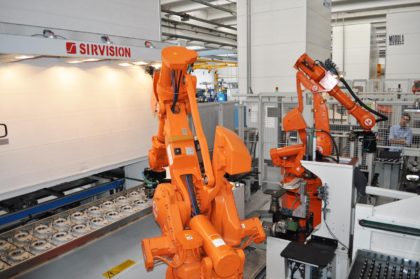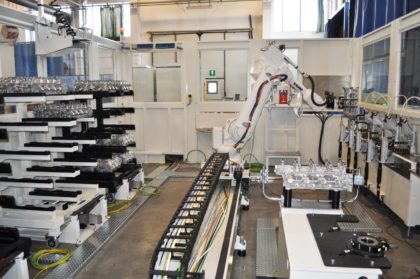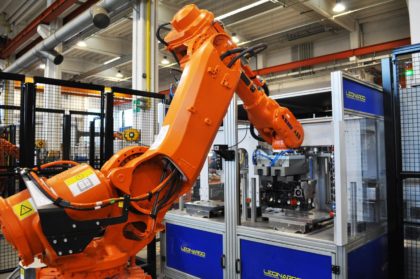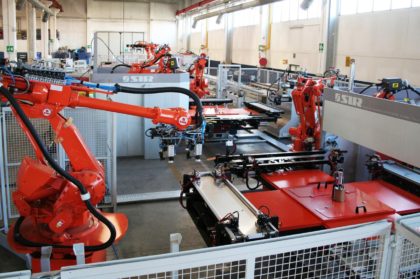“The birth of a SIR robotic system, from R&D to the functioning plant. A well-proven technological process, with a scope of use covering all the applications of robotics, from the small loading/unloading unit to the most complex of assembly plants”
A GENUINE DESIGN ENGINEERING DEPARTMENT
The birth of a robotic system is an extremely fascinating process, involving various fields of knowledge, in a natural osmosis of different but complementary disciplines: electronics, mechanical engineering, information technology or economics. SIR Soluzioni Industriali Robotizzate is able to provide expert management of this genesis through a well-established organisation. One of the world’s leading System Integrators, SIR is untypical: rather than a conventional production unit, it is really more one big design engineering department, but capable of translating into practice and actually building the projects it develops. It is a world where nothing is standard, where every single application is a prototype, a new challenge to the laws of automation and flexibility. Creating a new robotic plant means not only integrating articulated manipulators, but also designing the whole context: special machinery, conveyors, and tending and control devices. Experience plays a fundamental role here: with more than 1900 jobs to its credit in completely different sectors and applications, SIR has gained the experience needed to solve all the problems linked to processing, assembly, advanced loading/unloading and palletisation systems.
THE IDEA IS BORN
But how is a robotic system really born? It all starts from the customer and its automation requirements: SIR builds customised applications, designed to solve the specific problem submitted to it. The Preliminary Design Department analyses firms’ needs and translates them into an idea capable of assuring greater flexibility and productivity, increased quality, and a reduction in production costs. These are the key-words, the guidelines an integrator must follow to find the right solution. It is not sufficient just to design the best configuration for a new system, already hard enough in itself; what is needed is consideration of what economic and organisational impact the solution proposed will have on the customer’s business. In other words, in this stage engineering is merged with economics and logistics, and electronics mixes with marketing. The involvement of the Research & Development department is also important; it must provide considerable input with regard to new technologies, capable of improving the solutions through procedures such as the virtual analysis of the system’s behaviour even when it is still in the gestation stage. The birth of the successful idea is undoubtedly the most thrilling moment in the realisation of a robotic system: the SIR design engineers have to identify the right layout for the future machines, basically starting from a blank sheet of paper, and offer the customer a way of automating his product. While the concepts used in the field of loading/unloading are fairly standardised, the range of options available becomes much more complex in process or flexible assembly operations. For example, in process machining operations, the engineers have to “think up” a whole trimming or finishing system, consisting not only of articulated robots but also of countless machining (cutting, milling and brushing) units, capable of ensuring constant reproducible quality, on pieces which often differ completely from each other, in a competitive cycle time. We must remember that we are talking about machining systems applied to a wide variety of sectors, including cast iron, aluminium, steel or plastic, and the components for finishing often have extremely small lot sizes. Here, SIR processing systems become more and more like small automatic workshops, highly integrated and occupying just a few square metres of space. In the field of flexible assembly, finding the right solution becomes even more complex: here the engineers have to decide how to automate not one but dozens of manual operations. The end result is the design of lines comprising dozens of robots, capable of the automatic assembly of air-conditioners, compressors, transmission units or automotive engines. These are just some of the lines SIR has constructed, where the robots must be perfectly integrated with auxiliary machinery and control stations, often genuine gems of mechanical and electronic engineering, all built by SIR itself.
THE PROJECT TAKES SHAPE
Once the system has been designed and the order has been placed, one might think that the job is half done, but that is not really the case. It is now time for the Mechanical and Engineering Design Departments to start their task of translating every single detail of the future system into an actual design. SIR has a strong belief in structured design, and rejects all improvisation in its projects. Nothing optimised can be created by just assembling robots and components in the customer’s production department, especially in very complex applications such as assembly or process machining. The right solution will always be achieved through proper design, if high standards in operational quantities, reliability and strength are to be maintained. In this stage, technology transfer acquires fundamental importance: SIR’s immense experience enables its design engineers to import and export ideas and solutions between apparently unrelated industrial sectors. Therefore, something designed specifically for the woodworking sector may come to be applied, with the appropriate modifications, in cast iron or plastic. This continual drawing from the deep well of corporate knowledge enables SIR to create unusual, original solutions, which often lead to patents and other forms of national and international recognition.
ENERGY AND CONTROL
Thanks to its new assembly department, impressively sized and built to take the largest lines, SIR is able to assemble its plants completely on its own premises and test them before delivery to the final customer. It is in this stage that we come to another of the key moments in the construction of a robotic plant: it is the time when the idea finally comes to life, when the robots start to move and function, fuelled and guided by energy and programming. Still in collaboration with the corporate Research & Development area, the SIR engineers work with the aid of the most advanced technologies: first and foremost, off-line programming systems, allowing entire machining processes to be implemented on virtual simulations of the real system, with savings of 90% compared to the conventional method. There are also the latest-generation vision systems, used not only for 2D or 3D robot piloting, but also for inspection, quality control or end-of-line verification of assembly. SIR also uses its vision systems for programming itself, thanks to the new patented EasyPath system, able to derive the profiles for machining automatically from a real piece and transform them instantaneously into immediately-usable robot programmes. In the SIR assembly department, one can observe the construction of small loading/unloading systems alongside the birth of massive lines, where kilometres of electrical cables operate hundreds of devices and where dozens of robots move in synchrony like a huge orchestra, conducted by man, whose enthusiasm and ingenuity has invented the whole amazing system.
JOURNEY’S END: CUSTOMER SATISFACTION
Once their tiniest details have been verified at SIR, the robotic systems are reassembled and commissioned on the customer’s premises. After a necessary period of assisted operation and training, SIR plants are often required to work on 2 or 3 shifts, almost always unattended. It is obvious that this can only be achieved through outstanding reliability and quality, characteristics which derive from the tried and tested design process that underlies every SIR realisation. There are many grounds for satisfaction for both parties, supplier and customer: the high standards and professionalism of the SIR after-sales service sustains a collaboration which often leads to real partnerships and the integration of plants already constructed with fresh equipment and implementations. After all, the dream of the automatic factory is shared by both the industrial and the system integrator: the difficulties to be overcome to automate not just one aspect but an entire production process require a series of innovations not only on the plants but also on the automated product itself. This concept of the global solution is the basis for the robotics of the future. SIR has already responded to this need, has given it form and substance, transformed it into concepts and projects, and rationalised it in physical reality, in the journey from idea to motion which underlies every automation project.
Davide Passoni
R&D Department
SIR spa






